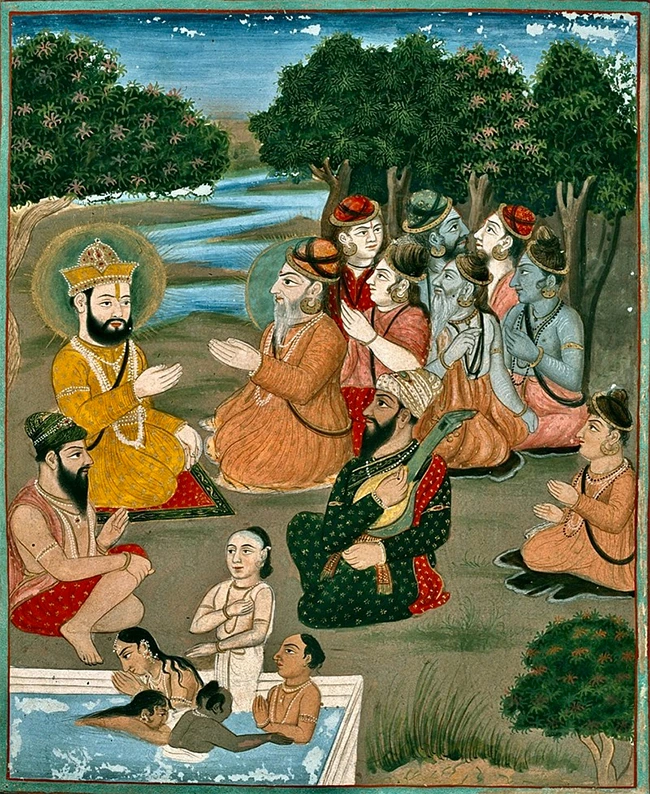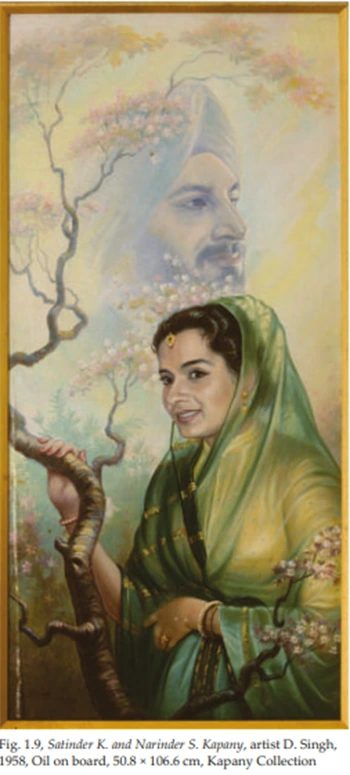Narinder Singh Kapany, the Father of Fibre Optics, created a communication revolution.
By KnowledgeVeto Tuesday, February 06, 2024 15:20

© Images Provided By (Online Search)
Narinder Singh Kapany (October 31, 1926 - December 4, 2020) was an Indian-American physicist best recognized for his work in fiber optics. Kapany is a pioneer in fiber optics, having coined and popularized the phrase. Fortune called him one of seven "Unsung Heroes of the 20th Century" for his Nobel Prize-worthy invention. He received India's second highest civilian honor, the Padma Vibhushan, posthumously in 2021. He worked as an Indian Ordnance Factories Service (IOFS) officer. Jawaharlal Nehru, India's first prime minister, also offered him the position of Scientific Adviser to the Defence Minister.
"In high school, a teacher told Kapany that light could travel only in a straight line. Kapany set out to prove him wrong and wound up creating fiber optics." (Fortune Magazine, 1999).
Dr. Kapany is widely regarded as the pioneer of fiber optics. His studies and inventions include fiber-optic communications, lasers, biomedical instruments, solar energy, and pollution monitoring. He holds over 100 patents and was a member of the National Inventors Council. He has received numerous honors, including 'The Excellence 2000 Award' from the United States Pan-Asian American Chamber of Commerce in 1998. He is a Fellow of several scientific groups, including the British Royal Academy of Engineering, the Optical Society of America, and the American Association for the Advancement of Science.

In Simple words What is Fibre Optic?
Fiber Optics, the science of transmitting data, voice, and images by the passage of light through thin, transparent fibers.

Provide Image from trickswizard
His Awards & Recognition
-> Pravasi Bharatiya Samman-> The Excellence 2000 Award
-> Fellow of the Royal Academy of Engineering[1] (1998)
-> Padma Vibhushan (2021)
Kapany was named a Padma Vibhushan awardee for 2021 after his death. The award is India's second highest civilian honour. In 2008, he earned the UC Santa Cruz Foundation's Fiat Lux Award. He also received the Pravasi Bharatiya Samman in 2004. In 1998, the USA Pan-Asian American Chamber of Commerce bestowed the "Excellence 2000 Award." In November 1999, Fortune named him one of the seven "unsung heroes who greatly influenced life in the twentieth century" in its "Businessmen of the Century" issue. Dr. Kapany was also named one of Time Magazine's top ten scientists of the twentieth century in the magazine's final edition in 1999.
Stream
-> Physics
Provide Image from khalsavox
Institutions
-> Agra University-> Ordnance Factories Board
-> Imperial College of Science
-> British Royal Academy of Engineering -> Optical Society of America
-> American Association for the Advancement of Science
-> Professor at the University of California, Berkeley (UCB)
-> University of California, Santa Cruz (UCSC)
-> Stanford University
Personal Life

Kapany was born on October 31, 1926, in Moga, Punjab, to Sundar Singh and Kundan Kaur. He came from a Sikh Khatri family of the Sodhi Clan, who were landlords. He finished his education in Dehradun and graduated from Agra University. He worked as an officer for the Indian Ordnance Factories Service before enrolling at Imperial College London in 1952 to pursue a Ph.D. in optics from the University of London, which he completed in 1955.
Kapany collaborated with Harold Hopkins at Imperial College on fiber transmission, successfully transmitting images across a huge bundle of optical fibers for the first time in 1953. Optical fibers have previously been used for picture transmission, but Hopkins and Kapany's technique resulted in significantly higher image quality than previously possible. This, together with the nearly simultaneous creation of optical cladding by Dutch scientist Bram van Heel, helped kick off the new area of fiber optics. Kapany originated the phrase "Fiber Optics" in a 1960 Scientific American article, produced the first book on the new area, and was the field's most notable researcher, writer, and publicist.
Kapany's research and work included fiber optics communications, lasers, biomedical instruments, solar energy, and pollution monitoring. He owned approximately 120 patents and was a member of the National Inventors Council. He was an International Fellow in a number of scientific groups, including the Royal Academy of Engineering, the Optical Society of America, and the American Association for the Advancement of Science.

Parents

Provide Image from sikhfoundation

Provide Image from sikhfoundation
Education & Entrepreneur
As an entrepreneur and corporate leader, Kapany specialized in innovation processes, technology management, and technology transfer. He started Optics Technology Inc. in 1960 and served as chairman of the board, president, and director of research for the next twelve years. In 1967, the corporation became public, following multiple corporate acquisitions and joint ventures in the United States and internationally. Kapany started Kaptron Inc. in 1973 and served as its president and CEO until 1990, when he sold it to AMP Incorporated. Kapany was an AMP Fellow for the following nine years, where he oversaw the Entrepreneur & Technical Expert Program and served as lead technology for worldwide communications.
He established K2 Optronics. He has also served on the boards of other companies. He was a member of the Young Presidents Organization, then the World Presidents Organization.
As an academic, Kapany taught and supervised postgraduate students research activities. He was a regents professor at both the University of California, Berkeley (UCB) and the University of California, Santa Cruz. He established the Center for Innovation and Entrepreneurial Development (CIED) at UCSC and served as director for seven years. At Stanford University, he was a visiting scholar in the Physics Department and a consultant professor in the Electrical Engineering Department.
Kapany, an author and professor, has written over 100 scholarly publications and four books on optoelectronics and entrepreneurship. He spoke at a variety of national and international scientific societies.
Interest towards Art

Provide Image from sikhfoundation
Kapany was an ardent philanthropist who supported education and the arts. He was the Sikh Foundation's founding chairman and a prominent supporter of its efforts for over 50 years. The Foundation operates publishing, academic, and artistic projects in conjunction with foreign organizations and publishers. In 1998, Kapany established a Chair of Sikh Studies at the University of California, Santa Barbara. In 1999, he donated $500,000 to the Asian Art Museum of San Francisco, establishing a gallery in its new building to display works from his Sikh art collection.
In 1999, he established the Chair of Optoelectronics at the University of California, Santa Cruz. In 2012, he established the Narinder Kapany Endowed Chair in Entrepreneurship at UC Santa Cruz. He was a trustee for the University of California, Santa Cruz Foundation. He also served as a trustee of the Menlo School in Menlo Park, California.
Kapany, an art collector, specializes in Sikh art. He lent paintings and other objects to the "Arts of the Sikh Kingdoms" exhibition, which opened in March 1999 at London's Victoria & Albert Museum. The exhibition then moved on to the Asian Art Museum of San Francisco (sponsored by the Sikh Foundation) before opening at the Royal Ontario Museum in Toronto in May 2000. Kapany organized "Splendors of the Punjab: Sikh Art and Literature in 1992" in partnership with the Asian Art Museum and UC Berkeley to commemorate the Sikh Foundation's 25th anniversary.
Dr. Kapany is an artist who made 40 "dynoptic" sculptures, which were initially presented in a one-man show at the Exploratorium at the Palace of Fine Arts in San Francisco in 1972. Since then, the collection has been exhibited in museums and art galleries in Chicago, Monterey, Palo Alto, and Stanford.
Spouse & Children's


Provide Image from sikhfoundation
Kiran Kaur Kapany(Daughter), Satinder Kaur Kapany(Wife) and Rajinder Singh Kapany(Son) (left to right).
Children's say: My mother and father met in London in 1950. She was studying dance and English literature. He was pursuing a Ph.D. in physics at the Imperial College of Science and Technology. Her wit and stunning beauty completely took him by surprise. They began their relationship as well as their interest in art, side by side, performing emotional, passionate, marvelous shadow dancing, and they married soon thereafter.
With the love of his life by his side, my father found the security and stability that enabled him to develop a revolutionary new idea: in 1951, his curiosity about the nature of light led him to challenge the conventional belief that light could not bend.
He wrote a Ph.D. thesis in which he demonstrated that, in fact, it could bend, and named his discovery "fiber optics" By virtue of that breakthrough, he has made an impact on the world that has continued to reverberate and has led him to be known as the "Father of Fiber Optics".
Dr. Kapany resides in the Bay Area with his wife, Satinder. His son, Rajinder, is a high-tech executive, while his daughter, Kiren, is an attorney and filmmaker. Kapany married Satinder Kaur in 1954, in London. She died in 2016.

Provide Image from sikhfoundation
Death
Kapany died on 4 December 2020, aged 94.












